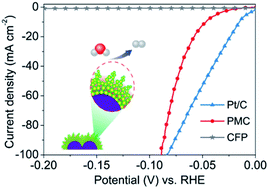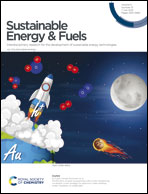The in situ removal of surface molybdenum oxide for making binder-free porous Mo1.98C1.02 film a more efficient electrocatalyst for alkaline rather than acidic hydrogen production†
Abstract
A binder-free structure is beneficial for effective electron transport in electrocatalysts. Although metallic carbides have been well demonstrated as a kind of efficient electrocatalysts in the hydrogen evolution reaction (HER), a binder-free film of metal carbides has rarely been developed. In addition, the role of surface molybdenum oxide during HER has not been assessed, and is easily formed on the surface of molybdenum carbides due to air exposure. Here we show the convenient and scalable growth of a binder-free film of porous molybdenum carbide (Mo1.98C1.02) on the surface of carbon fiber paper. The nanoparticles of molybdenum carbide showed a clean surface. The resultant structure exhibited prominent catalytic activity in HER, reaching a current density of 10 mA cm−2 in alkaline solution at an overpotential of 47 mV, while that in acidic electrolyte occurred at an overpotential of 63 mV. The binder-free film of porous molybdenum carbide could sustain its activity in long-term HER. Comparative experiments showed that the superb performance of the binder-free film of porous molybdenum carbide was correlated with its binder-free structure, in situ removal of surface oxide, and the optimal amount of residual carbon in the film.



 Please wait while we load your content...
Please wait while we load your content...